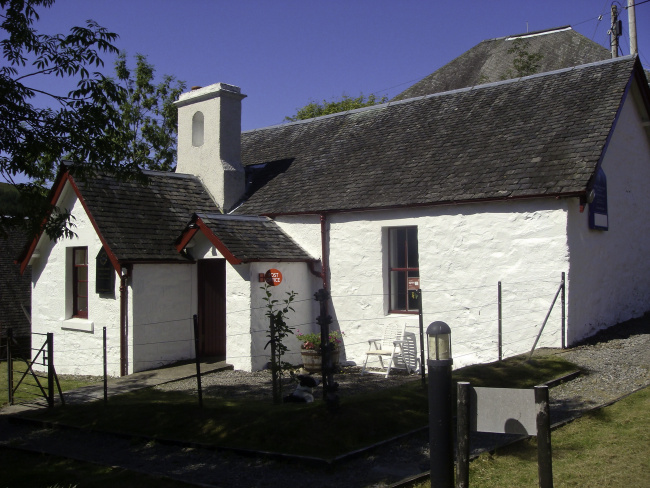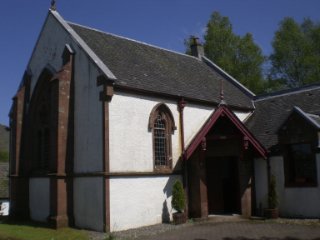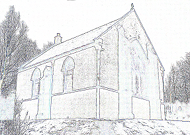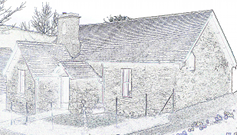Churches in Strathfillan
There are two places of worship in the parish of Strathfillan:
Bridge of Orchy Church

The church at Bridge of Orchy is the smaller of the two churches in the parish of Strathfillan. Nowadays the church building is dominated by the Bridge of Orchy Hotel. Tourists driving along the A82 are unlikely to miss the hotel but may well overlook the perfectly proportioned little church as they pass by on a road that, like the hotel, did not exist when the church was built in the 18th century nearly 250 years ago.
A photograph taken in the 1920s, before either the modern A82 or hotel were built, shows Bridge of Orchy Church and a building identified as the local Free Church. The Free Church would have been erected after the major disruption in 1843. The Free Church is not shown on the first edition of the OS map for Argyll based on a survey in 1870 and published in 1874, but does appear on the revised second edition, based on surveying first in 1867, then revised in 1897 before publication in 1900. Bridge of Orchy Church features in both editions at the site where it stands today. The Free Church has since been demolished.
Accurate information, derived from secure primary sources, concerning the origins of the building remains elusive. There appears to be no record of the building at the headquarters of the Church of Scotland in Edinburgh and no readily accessible information in the National Archives of Scotland. There is no evidence of a church at Bridge of Orchy in Roy’s map of Scotland published in 1750. However, on page 36 of Dalmally and the Glens (written and researched by McGrigor and published in 1976 by The Oban Times) we read “Bridge of Orchy has long been a meeting place of the folk of the upper glen and was therefore the natural site for a Church. In 1770, Lady Breadalbane persuaded her husband to pay for two missionaries for the hinterland of the west coast and shortly after this the Church was built as a ‘Chapel of Ease’. In 1882 the Church was renovated and at the same time the Parish of Strathfillan was divided from Killin.” A revised edition of Dalmally and the Glens was released in 2001 and McGrigor, on page 40, retains the account but with the revised dates of circa 1770 and 1880.
What was the purpose of a ‘Chapel of Ease’? Local tradition accepts that such a chapel was the place where a coffin might rest before a funeral. There is a wooden bench some 22 inches in width in the vestry at Bridge of Orchy Church that would serve to support a coffin. Or was a ‘Chapel of Ease’ intended to provide residents and travellers with a place to rest and reflect? The church at Bridge of Orchy is indeed a calming, tranquil sanctuary with no ornamentation or decoration to distract those who seek respite from the hurly-burly of the 21st century.
Crianlarich Church

History (with thanks to the Crianlarich Hotel)
Throughout most of the post-reformation period, Crianlarich was in the parish of Killin, but it enjoyed some religious provision in neighbouring Strathfillan. It was not until 1901 that the present Parish Church was commissioned, to the design of architect Thomas Ross (1839 – 1930). Historic Scotland describes it in glowing terms: “This tiny harled, Gothic, pitched roof church with red sandstone ashlar dressings, buttressing, cill and eaves course and angle margins remains largely as it was built and its acute sense of proportion coupled with excellent detailing lift it above the norm.
“The West gable has a Geometric window with quatrefoil detailing flanked by buttresses and a small stone cross at the apex. The South elevation is single bay with the lower single bay vestry with its gabel-headed window adjoining at right angles. In the re-entrant angle is the angled entrance which has a 2-leaf timber door and a timber pitched roof bracketed entrance canopy with finial detail. The East elevation is blank. On the North elevation 2 trefoil-headed windows flank a buttress. There are cast-iron rainwater goods.
INTERIOR “…the single bay nave has an open timber roof with a kingpost truss. The interior is whitewashed with a boarded timber dado and there is simple coloured glass to the square leaded panes of the windows. There are boarded timber pews. There is an en suite oak font and communion table with trefoil detailing and a timber pulpit.”
Crianlarich is now part of a much enlarged Church of Scotland charge… Other churches have existed, for example the Scottish Episcopal Church opened a mission for railway workers in the village in 1891, served initially by Rev. John Branford and from 1893 by the clergy in Callander; that mission closed in 1894. Another such mission was based in the small corrugated-iron building to be seen beside the northeast side of the road below the Glenbruar Viaduct, known as “The Evergreen”. This was the United Free Church Mission Station which was opened in 1910 and operated until 1929.



